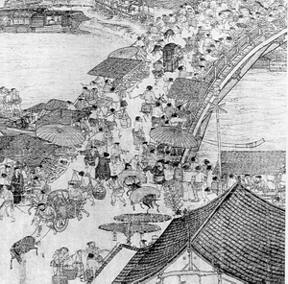- reason: attacks by Liao and Xi Xia (Tangut empire: 1038-1227);
- Song attempt to improve their defense system; peace treaty with Xi Xia in
1044
“New Laws” of Wang Anshi (1021-1086; chancellor 1068-1076, recalled 1078) to increase agricultural productivity; characteristics: liberal, egalitarian tendencies, sometimes called ‘socialist’.
1. - against massive purchases of grain to prevent price manipulation
2. - authorization of transforming labor service obligations into payments
3. - state loans at low interest rates for farmers (‘green-sprouts-loan’)
4. - irrigation systems improved
5. - knowledge of agricultural procedures enhanced through distribution of manuals
6. - state participation in business affairs
7. - good emoluments for officials (probably the best in Chinese history)
8. - establishment of public schools
9. - creation of peasant militias (baojia): units of ten families, regularly trained, supplied with arms (to reduce the enormous numbers of the regular army)
10. – households registered according to size of property and amount of persons which caused severe opposition
11. registration of privileged households (officials, widows, household with only one male bread winner)
12. creation of public welfare institutions: orphanages, hospitals, dispensaries, public cemeteries, reserve granaries (’ever-level granaries’) in every district (to meet demands during times of famine; system existed with alterations for 900 years)
13. Permanent training of the army
14. Geography and economics as exam subjects
15. Tea and Horse Agency established (Chinese tea for Tibetan horses; merchants were recruited)
Five categories of self-reliant landowning farmers:
1. owned more than ca. 19,5 ha and up to 650 ha
2. owned ca. 6,5 ha to ca. 19,5 ha
3. “
4. owned between 1,3 ha and max. 6,5 ha
5. owned between 1950 m2 and 1,3 ha; they usually rented additional land in order to support their families
- supremacy of civil over military power: discouragement of autonomous activities by military units through division of responsibilities and establishing controls
- mercenary army: long periods of inactivity
- gunpowder (first mentioned 1044) facilitated the production of new weapons: grenades
- creation of a navy patrolling the Yangzi and the coast
- Formation of large estates (zhuangyuan) in privileged private hands: imperial clan members, monasteries, landowners (who were taxed); concentration of land burdened the small farmers; reformer Jia Sidao (1213-1275): land reform in the footsteps of Wang Anshi: limited property clans to 27 ha.
- Revenues from the created public land: used to support the army.
- Heavy opposition against the reforms: nevertheless: 20% of Lower Yangzi area became public land (which ironically later served the Mongols to support their troops.)
- Urban expansion: Kaifeng: example of a commercialized city; walled wards given up in favor of street centered commercial activities; entertainment in restaurants (some with their own theaters) by day and night (abolishment of nightly curfew in 1063)


Detail 2

Detail 3
- Increased mobility: merchants and transport workers (boatmen etc.) using a large fleet of boats built for specific purposes; river – lake –canal water transport system: 50,000 km + coastal shipping + international maritime trade
- Growth of food production (improved irrigation and fertilization): multiple- harvest of rice (dry-rice, wet-rice, early ripening rice, late ripening rice, fragrant rice, sticky rice, red rice growing on salty soil; use of fields rotating: beans, ginger, vegetables like squash, cabbage, leeks, cucumbers, garlic, onions etc. ); tea (prepared with boiled non-salted water); sugar cane; citrus fruits; soy beans
- Growth of handicraft production by demand of a growing urban bourgeoisie consisting of merchants and landowners: textiles (hemp, cotton, ramie, banana fibres, mulberry trees); mining and foundries; kilns for ceramics and porcelain (production perfected in the12th century; exports to Japan, Philippines, Southeast Asia (Borneo), Africa); printed books (woodblock printing – with illustrations- technically perfected and commercially propelled: historical encyclopedias, sutras, manuals for officials, exam manuals, primers, historical works, editions of the Nine Classics; maps; works on botany, zoology; historical geography, archaeology); movable type printing (first mentioned in 1086); furniture; clothing; imports of luxury goods; imitations of antiques
- Monetary economy: promissory notes (cheques), paper money
- Academies (shuyuan) multiplied (schools: public, private, schools associated with libraries, schools of Buddhist monasteries)
- Historiography: critical reflection instead of chronological accounts of events;
- Footbinding since the tenth century (dancers); fashion followed at court and in families emulating upper-class lifestyle
- Integrating the natural/ cosmic order with human/ ethic order: naturalist, rational philosophy dominant
- Return to original Confucian tradition preserved in the Classics; though influenced by Buddhist asceticism rejection of Buddhism; objective: improving society through politics via education
- Systematization: search for explanation of the universe; reasons of cosmic evolution; search for universal harmony
- Creation of a new canon of classical texts [Four Books]: 1. Analects of Confucius, 2. Mencius, 3. the Great Learning & the 4. Doctrine of the Mean ( 3 & 4 contained in the Treatises on the Rites [Liji]).
- Zhu Xi (1130-1200): School of Human Nature and Universal Order (xing-li-xue): Neo-Confucianism